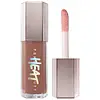NYX Cosmetics Fat Oil Lip Drip Versus Fenty Beauty Gloss Bomb Heat Universal Lip Luminizer + Plumper
What's inside
What's inside
 Key Ingredients
Key Ingredients

 Benefits
Benefits

 Concerns
Concerns

 Ingredients Side-by-side
Ingredients Side-by-side

Polyisobutene
Hydrogenated Polyisobutene
EmollientPentaerythrityl Tetraisostearate
EmollientParaffinum Liquidum
EmollientDiisostearyl Malate
EmollientPolyglyceryl-3 Diisostearate
EmulsifyingRosa Canina Fruit Oil
EmollientRubus Chamaemorus Seed Oil
Skin ConditioningRubus Idaeus Seed Oil
EmollientSqualane
EmollientAroma
Caprylic/Capric Triglyceride
MaskingDibutyl Ethylhexanoyl Glutamide
Skin ConditioningEthylhexylglycerin
Skin ConditioningTocopherol
AntioxidantTocopheryl Acetate
AntioxidantDiethylhexyl Syringylidenemalonate
Skin ProtectingSorbic Acid
PreservativePhenoxyethanol
PreservativeBenzyl Alcohol
PerfumingPolyisobutene, Hydrogenated Polyisobutene, Pentaerythrityl Tetraisostearate, Paraffinum Liquidum, Diisostearyl Malate, Polyglyceryl-3 Diisostearate, Rosa Canina Fruit Oil, Rubus Chamaemorus Seed Oil, Rubus Idaeus Seed Oil, Squalane, Aroma, Caprylic/Capric Triglyceride, Dibutyl Ethylhexanoyl Glutamide, Ethylhexylglycerin, Tocopherol, Tocopheryl Acetate, Diethylhexyl Syringylidenemalonate, Sorbic Acid, Phenoxyethanol, Benzyl Alcohol
Polybutene
Octyldodecanol
EmollientBis-Diglyceryl Polyacyladipate-2
EmollientTricaprylin
MaskingCera Microcristallina
Emulsion StabilisingHydrogenated Polyisobutene
EmollientPolyethylene
AbrasiveSilica Dimethyl Silylate
EmollientButyrospermum Parkii Butter
Skin ConditioningVp/Eicosene Copolymer
Sorbitan Oleate
EmulsifyingVp/Hexadecene Copolymer
Silica
AbrasiveEthylhexyl Palmitate
EmollientCaprylyl Glycol
EmollientAroma
Parfum
MaskingOctyldodecyl Neopentanoate
EmollientButyrospermum Parkii Butter Unsaponifiables
Skin ConditioningTribehenin
EmollientMica
Cosmetic ColorantPentaerythrityl Tetra-Di-T-Butyl Hydroxyhydrocinnamate
AntioxidantMethyl Nicotinate
SoothingSorbitan Isostearate
EmulsifyingTocopherol
AntioxidantTocopheryl Acetate
AntioxidantVanillyl Butyl Ether
MaskingCapsicum Frutescens Fruit Extract
Skin ConditioningGlycine Soja Oil
EmollientZingiber Officinale Root Oil
MaskingSynthetic Fluorphlogopite
Tetrahexyldecyl Ascorbate
AntioxidantLactic Acid
BufferingCalcium Sodium Borosilicate
Calcium Aluminum Borosilicate
Palmitoyl Tripeptide-1
Skin ConditioningTin Oxide
AbrasiveBenzyl Benzoate
AntimicrobialLimonene
PerfumingIron Oxides
CI 15850
Cosmetic ColorantCI 77891
Cosmetic ColorantPolybutene, Octyldodecanol, Bis-Diglyceryl Polyacyladipate-2, Tricaprylin, Cera Microcristallina, Hydrogenated Polyisobutene, Polyethylene, Silica Dimethyl Silylate, Butyrospermum Parkii Butter, Vp/Eicosene Copolymer, Sorbitan Oleate, Vp/Hexadecene Copolymer, Silica, Ethylhexyl Palmitate, Caprylyl Glycol, Aroma, Parfum, Octyldodecyl Neopentanoate, Butyrospermum Parkii Butter Unsaponifiables, Tribehenin, Mica, Pentaerythrityl Tetra-Di-T-Butyl Hydroxyhydrocinnamate, Methyl Nicotinate, Sorbitan Isostearate, Tocopherol, Tocopheryl Acetate, Vanillyl Butyl Ether, Capsicum Frutescens Fruit Extract, Glycine Soja Oil, Zingiber Officinale Root Oil, Synthetic Fluorphlogopite, Tetrahexyldecyl Ascorbate, Lactic Acid, Calcium Sodium Borosilicate, Calcium Aluminum Borosilicate, Palmitoyl Tripeptide-1, Tin Oxide, Benzyl Benzoate, Limonene, Iron Oxides, CI 15850, CI 77891
 Reviews
Reviews

Ingredients Explained
These ingredients are found in both products.
Ingredients higher up in an ingredient list are typically present in a larger amount.
Aroma refers to an ingredient, or mixture of ingredients, that impart or mask a flavor.
The name is slightly confusing. This is because INCI associates aroma with flavor instead of smell.
Here is the official definition from the The International Cosmetic Ingredient Dictionary and Handbook:
“Aroma is a term for ingredient labeling used to identify that a product contains a material or combination of materials normally added to a cosmetic to produce or to mask a particular flavor.”
INCI shows the only purpose of aroma to be "flavouring".
However, due to regulation differences, some companies may use aroma in place of parfum.
In Canada, this ingredient only has to be listed in concentrations above 1%.
Learn more about AromaHydrogenated Polyisobutene is a synthetic polymer. Polymers are compounds with high molecular weight. Hydrogenated Polyisobutene is an emollient and texture enhancer.
In one study, Hydrogenated Polyisobutene showed better skin hydration levels than Caprylic/Capric Triglyceride. As an emollient, it helps keep your skin soft and hydrated by trapping moisture in.
Hydrogenated Polyisobutene is often used as a mineral oil replacement.
Learn more about Hydrogenated PolyisobuteneTocopherol (also known as Vitamin E) is a common antioxidant used to help protect the skin from free-radicals and strengthen the skin barrier. It's also fat soluble - this means our skin is great at absorbing it.
Vitamin E also helps keep your natural skin lipids healthy. Your lipid skin barrier naturally consists of lipids, ceramides, and fatty acids. Vitamin E offers extra protection for your skin’s lipid barrier, keeping your skin healthy and nourished.
Another benefit is a bit of UV protection. Vitamin E helps reduce the damage caused by UVB rays. (It should not replace your sunscreen). Combining it with Vitamin C can decrease sunburned cells and hyperpigmentation after UV exposure.
You might have noticed Vitamin E + C often paired together. This is because it is great at stabilizing Vitamin C. Using the two together helps increase the effectiveness of both ingredients.
There are often claims that Vitamin E can reduce/prevent scarring, but these claims haven't been confirmed by scientific research.
Learn more about TocopherolTocopheryl Acetate is AKA Vitamin E. It is an antioxidant and protects your skin from free radicals. Free radicals damage the skin by breaking down collagen.
One study found using Tocopheryl Acetate with Vitamin C decreased the number of sunburned cells.
Tocopheryl Acetate is commonly found in both skincare and dietary supplements.
Learn more about Tocopheryl Acetate